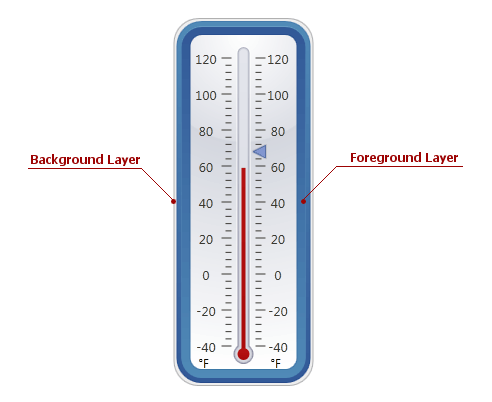LinearScaleLayer Class
A layer that contains properties to define the visual presentation of a linear scale.
Namespace: DevExpress.Xpf.Gauges
Assembly: DevExpress.Xpf.Gauges.v25.2.dll
NuGet Package: DevExpress.Wpf.Gauges
Declaration
Remarks
A layer specifies the appearance of the linear scale’s elements. It is represented by LinearScaleLayer object contained in the LinearScaleLayerCollection object, which can be accessed via the LinearScale.Layers property.
When a new layer is added to the linear scale, it is painted behind all other elements, because by default, its LayerOptions.ZIndex is less than other elements. If you want to display the layers in front of other scale elements, set their Zindex to a greater value.
The following image illustrates this layer’s appearance.

Example
This example illustrates how to create a LinearGaugeControl instance with two LinearScale objects.
<Window x:Class="DXGauges_Linear.MainWindow"
xmlns="http://schemas.microsoft.com/winfx/2006/xaml/presentation"
xmlns:x="http://schemas.microsoft.com/winfx/2006/xaml"
xmlns:dxga="http://schemas.devexpress.com/winfx/2008/xaml/gauges"
Title="MainWindow" Height="450" Width="525">
<Grid>
<dxga:LinearGaugeControl Name="linearGaugeControl1" Margin="0,24,0,20">
<dxga:LinearGaugeControl.Model>
<dxga:LinearRedThermometerModel/>
</dxga:LinearGaugeControl.Model>
<dxga:LinearGaugeControl.Scales>
<dxga:LinearScale StartValue="-40" EndValue="120"
MajorIntervalCount="8" Width="60">
<dxga:LinearScale.Ranges>
<dxga:LinearScaleRange EndValue="32" StartValue="-40">
<dxga:LinearScaleRange.Presentation>
<dxga:DefaultLinearScaleRangePresentation Fill="LightBlue" />
</dxga:LinearScaleRange.Presentation>
</dxga:LinearScaleRange>
<dxga:LinearScaleRange EndValue="120" StartValue="32">
<dxga:LinearScaleRange.Presentation>
<dxga:DefaultLinearScaleRangePresentation Fill="Tomato" />
</dxga:LinearScaleRange.Presentation>
</dxga:LinearScaleRange>
</dxga:LinearScale.Ranges>
<dxga:LinearScale.CustomLabels>
<dxga:ScaleCustomLabel Content="°F" Offset="-45" Value="-45" />
</dxga:LinearScale.CustomLabels>
<dxga:LinearScale.Layers>
<dxga:LinearScaleLayer/>
</dxga:LinearScale.Layers>
<dxga:LinearScale.LevelBars>
<dxga:LinearScaleLevelBar Value="59" />
</dxga:LinearScale.LevelBars>
</dxga:LinearScale>
<dxga:LinearScale StartValue="-40" EndValue="120"
MajorIntervalCount="8" Margin="68,0,0,0" >
<dxga:LinearScale.Ranges>
<dxga:LinearScaleRange StartValue="-40" EndValue="32" >
<dxga:LinearScaleRange.Presentation>
<dxga:DefaultLinearScaleRangePresentation Fill="LightBlue" />
</dxga:LinearScaleRange.Presentation>
</dxga:LinearScaleRange>
<dxga:LinearScaleRange StartValue="32" EndValue="120" >
<dxga:LinearScaleRange.Presentation>
<dxga:DefaultLinearScaleRangePresentation Fill="Tomato" />
</dxga:LinearScaleRange.Presentation>
</dxga:LinearScaleRange>
</dxga:LinearScale.Ranges>
<dxga:LinearScale.Markers>
<dxga:LinearScaleMarker Value="68" />
</dxga:LinearScale.Markers>
<dxga:LinearScale.CustomLabels>
<dxga:ScaleCustomLabel Content="°F" Offset="-7" Value="-45" />
</dxga:LinearScale.CustomLabels>
<dxga:LinearScale.LabelOptions>
<dxga:LinearScaleLabelOptions Offset="3" />
</dxga:LinearScale.LabelOptions>
<dxga:LinearScale.MinorTickmarkOptions>
<dxga:MinorTickmarkOptions Offset="-16" />
</dxga:LinearScale.MinorTickmarkOptions>
</dxga:LinearScale>
</dxga:LinearGaugeControl.Scales>
</dxga:LinearGaugeControl>
</Grid>
</Window>
Related GitHub Examples
The following code snippet (auto-collected from DevExpress Examples) contains a reference to the LinearScaleLayer class.
Note
The algorithm used to collect these code examples remains a work in progress. Accordingly, the links and snippets below may produce inaccurate results. If you encounter an issue with code examples below, please use the feedback form on this page to report the issue.